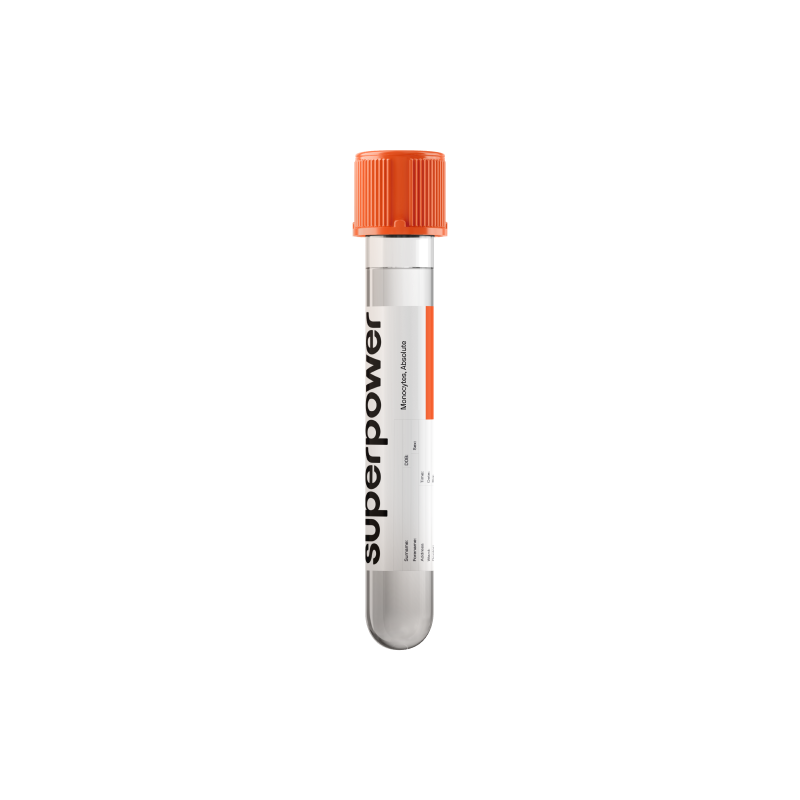Monocytes, Absolute testing reports the actual number of circulating monocytes in your blood, offering insight into immune balance, recovery after illness, and chronic inflammation patterns. It is part of a Complete Blood Count (CBC) with differential and provides stronger context than percentages alone.
Key Benefits
- Check monocyte count, a white blood cell responding to chronic inflammation.
- Spot smoldering infections or inflammatory disorders when monocytes stay persistently elevated.
- Flag recovery after acute illness or surgery, when transient monocytosis commonly appears.
- Clarify unexplained fatigue, fevers, or weight loss by signaling chronic inflammatory activity.
- Guide evaluation for hematologic disease when counts are markedly high and persistent.
- Detect low monocytes linked to steroids, sepsis, HIV, or bone marrow suppression.
- Track treatment response in chronic infections, autoimmune conditions, and certain blood cancers.
- Best interpreted with total WBC, differential, CRP or ESR, and symptoms.
What is Monocytes, Absolute?
Monocytes, Absolute is the total number of monocytes circulating in your blood at the time of the test. Monocytes are a type of white blood cell made in the bone marrow from myeloid precursors (hematopoietic myeloid lineage). After release, they travel in the bloodstream for a short time before entering tissues, where many mature into macrophages or dendritic cells—cells that reside in organs and connective tissues and continue immune surveillance.
Monocytes are frontline cleaners and coordinators. They ingest germs and debris (phagocytosis), sense trouble, and release signaling molecules (cytokines, chemokines) that call in and direct other immune cells. They also process and display fragments of invaders to activate targeted immunity (antigen presentation to T cells). In tissues, their descendants help contain infection, resolve inflammation, and guide repair. The absolute monocyte count reflects the size of this circulating patrol—how many cells are available to be deployed from blood into tissues—and indirectly mirrors bone marrow production and the body’s current need for surveillance, clean‑up, and healing within the innate immune system.
Why is Monocytes, Absolute important?
Monocytes, Absolute tells you how many of the body’s “cleanup and coordination” white blood cells are circulating. Monocytes patrol the blood, then enter tissues to become macrophages and dendritic cells that clear microbes and debris, present antigens, and orchestrate repair. Because they sit at the crossroads of infection defense, wound healing, and vascular inflammation, their level reflects immune tone across many organ systems.
Most labs define a typical range around 0.2–0.8, and values in the middle generally indicate balanced surveillance without excess inflammation. Children can run slightly higher in early years, and pregnancy often shows a mild rise; sex differences are small.
When the number is below range, it usually reflects reduced production or redistribution of monocytes. This can occur with bone marrow suppression (for example after chemotherapy), high corticosteroid exposure or acute physiologic stress, and certain marrow or immune disorders. People may notice more frequent or lingering infections, mouth ulcers, slower wound healing, or fatigue, and other white cell lines may also be low.
When it’s above range, the body is often signaling ongoing inflammation or tissue turnover. Chronic infections, autoimmune or granulomatous diseases, inflammatory bowel disease, recovery after an acute infection, and removal of the spleen can raise counts. Very high or persistent elevations can point to myeloid blood disorders. Symptoms can include fevers, night sweats, weight loss, joint pain, or an enlarged spleen, and arteries may be affected through atherosclerotic plaque activity.
Big picture: absolute monocytes link innate immunity to tissue remodeling and cardiovascular biology. Interpreted alongside neutrophils, lymphocytes, platelets, and CRP, they help map inflammatory load and, over time, relate to risks for chronic infection, atherosclerosis, and myeloid disease.
What Insights Will I Get?
What Monocytes, Absolute tells you
This biomarker counts the number of monocytes circulating in your blood. Monocytes are frontline immune cells that patrol blood vessels, migrate into tissues, and mature into macrophages and dendritic cells. They clear microbes and debris, coordinate inflammation, and influence vessel health, lipid handling, and tissue repair—linking immunity to metabolism, cardiovascular risk, and recovery from illness.
Low values usually reflect reduced bone marrow output or redistribution out of blood. Common drivers include acute physiological stress or glucocorticoid exposure, severe infection with marrow suppression, nutrient or systemic illnesses that depress cell production, or hypersplenism. Rare inherited marrow disorders can also lower counts. System-level effects can include less robust early innate responses and slower cleanup of tissue damage. In pregnancy, true lows are uncommon; in children, transient lows are often contextual.
Being in range suggests balanced innate immune surveillance with adequate capacity for pathogen clearance and repair without excess inflammatory signaling. For most adults, optimal tends to sit near the middle of the reference interval, reflecting steady marrow production and stable vascular–tissue patrolling.
High values usually reflect ongoing or recent inflammatory signaling that mobilizes monocytes. This is seen with chronic infections, autoimmune or granulomatous conditions, smoking, recovery after an acute infection, and some bone marrow disorders such as chronic myelomonocytic leukemia. System-level impacts can include heightened cytokine tone, greater macrophage activity in tissues, and, over time, more lipid-laden macrophages in vessel walls that can influence atherosclerosis risk. Mild increases are common in late pregnancy and in older adults.
Notes: Interpret alongside the total white blood cell count and the full differential. Counts fluctuate with acute illness, surgery, stress, circadian timing, and certain medications (notably corticosteroids). Age and pregnancy modestly shift typical values.



.svg)



.png)
.png)
.png)
.png)








